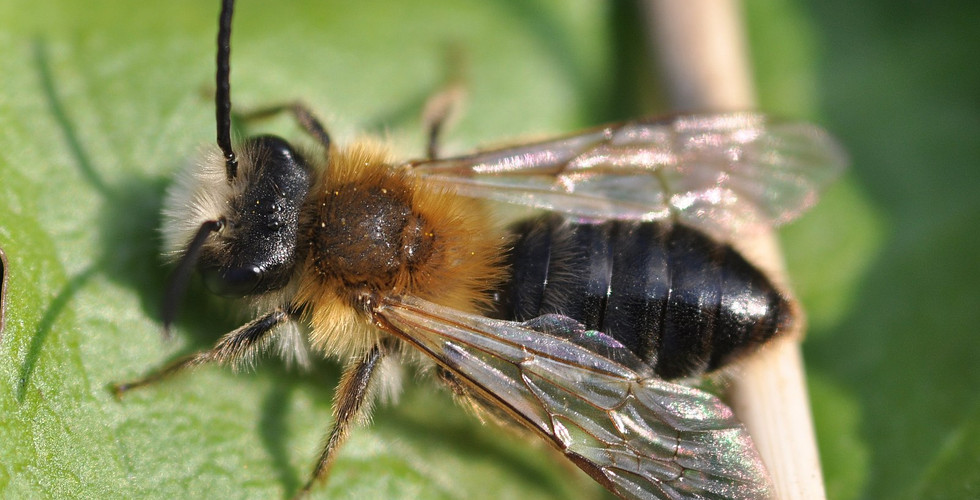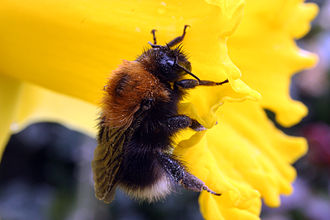Storytelling to Bridge the Gap Between Science and the Public
- Sofia Dartnell
- Apr 29, 2024
- 5 min read
Updated: May 2, 2024
Close your eyes and imagine a bee.
Maybe you’re picturing a cartoon, along the lines of the 2007 “Bee Movie.” Perhaps you’re imagining a group of insects tending to a honey-filled comb.
Everyone knows something about bees, may it be through media or an accidental sting. Perhaps you grew up in an area with local beekeepers, or learned about their intricate waggle dance communication in school. Wherever I go, I find some sort of houseware decorated with their signature gold and black stripes, and often a cutesy motivational phrase (“bee yourself” or “let it bee”).
If I had to bet, you’re not picturing something small and green.
By definition, a bee is an insect (meaning a creature with three body parts and six legs) with two sets of wings that feeds on pollen and nectar. Colour is not a defining characteristic. You may also be surprised to learn that of Earth’s more than 20,000 bee species, only four make honey. So where are the stories of these other bees? I am quite fond of these “alternative” pollinators – I study parasitic bumblebees. As a PhD student with one foot in education and the other in research, I have come to realise the power of storytelling, both in academia and public outreach. I believe these stories spark a sympathy for nature, which is central to effective conservation.
Some of the UK’s non-honeybee bees. Left to right: Common Carder Bee (Bombus pascuorum), Tawny Mining Bee (Andrena fulva), Tree Bumblebee (Bombus hypnorum), Grey-patched Mining Bee (Andrena nitida). For attribution check [1].
Biology was my favourite subject growing up. I fondly recall the paper mâché palm trees and cardboard animals my Kindergarten teacher used to create a miniature Amazon rainforest in our classroom. We spent days talking about interesting jungle creatures inhabiting the area, from sleepy sloths to red-eyed tree frogs. What if we applied the same approach to lessons on bees in our backyard?
The tale of the parasitic bumblebees I study is one of evolutionary exploitation. Like honeybees, bumblebees are social, meaning the queen and her workers live and work together, foraging for pollen and nectar and raising generations of bumblebees. Queen bumblebees spend their winters hibernating underground. When the weather is warm enough, typically around March in the UK, they emerge from the soil and get to work collecting pollen and digging a hole underground, where the queen starts laying her first batch of workers.
The parasitic ‘cuckoo’ bumblebees I study have adopted a different lifestyle. Rather than investing time and energy into collecting provisions and raising their own workers, they hit the snooze button and enjoy an extended hibernation underground. And when they wake, they choose a path of stealth and deception. Using pheromone camouflage (essentially nature’s version of the invisibility cloak), the cuckoo bumblebee sneaks into a ready-established colony and takes over as queen, convincing the conquered workers of her host species to help raise her parasitic brood instead.

A cuckoo bumblebee (Bombus vestalis). Image credit to Alvesgaspar, licensed under the Creative Commons Attribution-Share Alike 3.0 Unported license, no changes made.
Beyond these bumblebees, Earth is also home to a multitude of solitary bee species that do not produce any workers. Rather, they lay their eggs in soil or wood and otherwise live on their own. Some of these bees have evolved unique behaviours to attract mates. My favourite example is the orchid bee, a metallic green species whose males zoom around the rainforest to find aromatic plants. By rubbing these scented volatiles onto their bodies, each male orchid bee curates a personalised perfume, which females use to choose their suitor. Certain orchids have evolved to take advantage of this behaviour as well, strategically trapping the male orchid bee temporarily to attach a packet of pollen to the eager male’s back for transport across the rainforest.
Certainly, stories of deception and flirtation within the Animal Kingdom are engaging. It has been exciting to join outreach events to educate on the importance of insects and share stories about the non-honey makers of the bee world. During Family Day at the Cambridge Museum of Zoology last spring, I was invited to set up a booth in the museum to tell children and their parents about bees and my research. Part of the fun, of course, was letting them hold my 2-metre insect net.

During our conversations, I invited kids to draw a bee using provided crayons. While many bees were classically yellow and black striped, I was impressed to see that some children had already heard of alternative pollinators, excitedly telling me about red-tailed bumblebees or hairy-footed flower bees they’d seen in their gardens. Others had not had the same exposure but were excited to tell me about the specimens they’d found displayed behind museum glass.
Often, when yellow and black crayons were occupied by other participants, the kids would ask me whether they could draw a bee in another colour (“I know they don’t exist, but I’m going to make mine blue”). Looks of hesitation shifted to shock when I pulled out photos of Australia’s blue-banded bees, or shiny green solitary bees from the U.S. It is moments like these that call for the stories of unsung pollinators.

In expanding our one-dimensional perception of bees as species that produce honey, we also gain appreciation and insight into the seemingly inconceivable biodiversity evolved on Earth, which seems to surpass even childhood imagination. And perhaps in caring for a small green or blue bee, people will start to notice trends in the flowers and insects they see in their own backyards.
Perhaps, with time, these narratives can also build sympathy for bees and lead to tangible policy changes. I would personally like to see a complete ban on the use of neonicotinoids in the UK. At the moment, the insecticide can be used in pet flea treatments and on crops under emergency authorization, and has been used to treat aphid-transmitted viruses in sugar beets for the past four years. While these chemicals are applied to reduce agricultural pests, they kill indiscriminately, with a highly negative impact on bees and other pollinators. Our era of intense land use change has led to what is known as ‘shifting baseline syndrome,’ the idea that our perception of what is ‘normal’ in nature has changed over time due to our lack of knowledge of how past habitats and diversity looked. Reshaping our narratives of bees is a first step in working towards a recognition of insect diversity and awareness of the implications of bee declines.
Now, close your eyes and imagine a bee once again…
The views expressed in this piece are solely those of the author(s) and do not reflect those of the Editorial Board, the Scholars’ Council, the Gates Cambridge Trust or the University of Cambridge.
From left to right: Image credit to André Karwath aka Aka, licensed under the Creative Commons Attribution-Share Alike 2.5 Generic license, no changes were made. Image credit to © entomart. Image credit to Charles J. Sharp, licensed under the Creative Commons Attribution-Share Alike 3.0 Unported license, no changes were made. Image credit to Aiwok, licensed under the Creative Commons Attribution-Share Alike 4.0 International license, no changes were made.
Sofia Dartnell ['22] is a Zoology PhD student focused on bumblebee conservation. She is currently studying cuckoo bumblebees and their habitat associations.







Commentaires